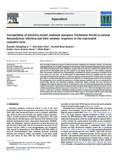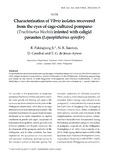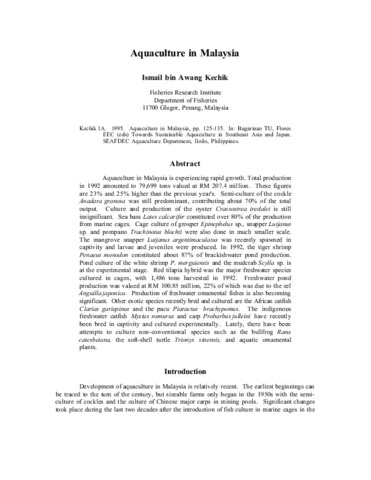Field evaluation of hydrogen peroxide bath technique for controlling sea lice (Lepeoptheirus spinifer) infestation in snubnose pompano (Trachinotus blochii)
- Global styles
- MLA
- Vancouver
- Elsevier - Harvard
- APA
- Help

View/Open
Date
2024-08Page views
340ASFA keyword
AGROVOC keyword
Taxonomic term
Geographic names
Metadata
Perlihat publikasi penuhCited times in Scopus
- Captures
- Mendeley - Readers: 2
Share
Abstract
Sea lice infestations can pose significant challenges in the aquaculture sector, affecting fish health and overall production. In the search for effective and eco-friendly solutions, hydrogen peroxide bath treatment has been considered as one of the promising methods. This is the first study to evaluate the field efficacy of hydrogen peroxide bath technique against sea lice infestation on cage-cultured snubnose pompano (Trachinotus blochii). Sea lice was identified as Lepeophtheirus spinifer using morphological description. Naturally-infested snubnose pompano stocked in 2 × 3 × 2 m3 net cages at 15 fish/cage at the Igang Marine Station of SEAFDEC/AQD, in Guimaras, Philippines were treated in triplicates with two hydrogen peroxide concentrations (1500 and 2000 ppm) in comparison to a control (seawater only) for 20 minutes at 32.8 ± 0.7 ppt and 28.9 ± 0.3 °C and were monitored at 3rd and 7th day post-treatment. The total mean intensity of sea lice, mean intensity per life stages (copepodid, chalimus I, chalimus II, pre-adult I, pre-adult II, adult male and adult female), and the 12-h viability of scraped male and adult female L. spinifer from the treatment groups were evaluated. The total mean intensity of sea lice in the treated groups at 3 day post-treatment was significantly lower than the control group (p < 0.001). A possible re-infection of sea lice was observed 7 days post-treatment as explained by the slight increase in the mean intensity in the treated groups. However, no mortalities of pompano were recorded throughout the experiment. In addition, adult female lice were absent in the treated group while adult male lice were only detected in the 1500 ppm treatment group at a very low mean intensity. The viability test also showed that all sea lice were not able to recover after 12 h whereas a 100 % recovery rate was noted in the control group. Results suggest that the 1500 and 2000 ppm hydrogen peroxide concentrations are effective in reducing sea lice infestation on cage-cultured snubnose pompano. However, a long-term effect of hydrogen peroxide treatment on sea lice needs further investigation.
Suggested Citation
Erazo-Pagador, G., Tesorero, M., & Caloyloy, B. J. (2024). Field evaluation of hydrogen peroxide bath technique for controlling sea lice (Lepeoptheirus spinifer) infestation in snubnose pompano (Trachinotus blochii). Veterinary Parasitology , 330, 110223. https://doi.org/10.1016/j.vetpar.2024.110223
Type
ArticleISSN
0304-4017Koleksi
- Journal Articles [1247]
Related items
Showing items related by title, author, creator and subject.
-
Susceptibility of hatchery-reared snubnose pompano Trachinotus blochii to natural betanodavirus infection and their immune responses to the inactivated causative virus
Pakingking, Rolando V., Jr. ; Mori, Koh-Ichiro; Bautista, Norwell Brian; de Jesus-Ayson, Evelyn Grace; Reyes, Ofelia (Elsevier, 2011)
Mass mortality of snubnose pompano Trachinotus blochii fry exhibiting dark coloration, anorexia, and abnormal swimming behavior was recently documented at the hatchery of the Aquaculture Department of the Southeast Asian ...1111 Total citations2 Recent citations1.2 Field Citation Ration/a Relative Citation Ratio
; Mori, Koh-Ichiro; Bautista, Norwell Brian; de Jesus-Ayson, Evelyn Grace; Reyes, Ofelia (Elsevier, 2011)
Mass mortality of snubnose pompano Trachinotus blochii fry exhibiting dark coloration, anorexia, and abnormal swimming behavior was recently documented at the hatchery of the Aquaculture Department of the Southeast Asian ...1111 Total citations2 Recent citations1.2 Field Citation Ration/a Relative Citation Ratio -
Characterisation of Vibrio isolates recovered from the eyes of cage-cultured pompano (Trachinotus blochii) infested with caligid parasites (Lepeophtheirus spinifer)
Pakingking, Rolando V., Jr. ; Bautista, Norwell B.; Catedral, Demy; de Jesus-Ayson, Evelyn Grace (European Association of Fish Pathologists, 2018)
Exophthalmia was documented among sea cage-cultured pompano (Trachinotus blochii) broodstocks with caligid parasite (Lepeophtheirus spinifer) infestation in the Philippines. Following sequencing, and based on the results ...
; Bautista, Norwell B.; Catedral, Demy; de Jesus-Ayson, Evelyn Grace (European Association of Fish Pathologists, 2018)
Exophthalmia was documented among sea cage-cultured pompano (Trachinotus blochii) broodstocks with caligid parasite (Lepeophtheirus spinifer) infestation in the Philippines. Following sequencing, and based on the results ... -
Aquaculture in Malaysia
Kechik, Ismail bin Awang. (Aquaculture Department, Southeast Asian Fisheries Development Center, 1995)Aquaculture in Malaysia is experiencing rapid growth. Total production in 1992 amounted to 79,699 tons valued at RM 207.4 million. These figures are 23% and 25% higher than the previous year's. Semi-culture of the cockle ...







